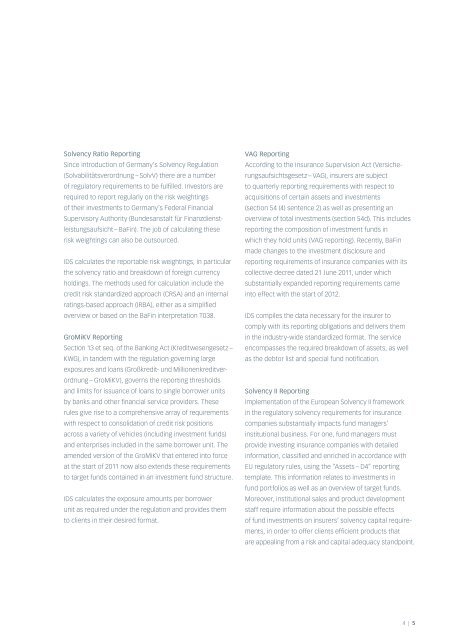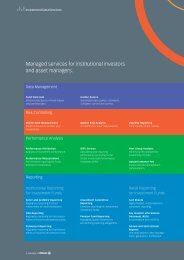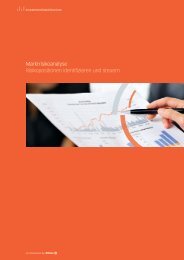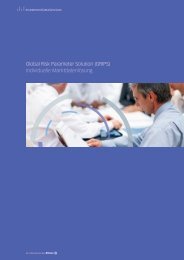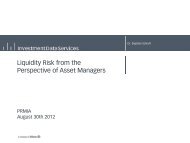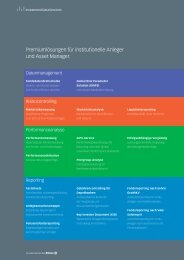Institutional Reporting First-class reporting to win and keep investors.
Institutional Reporting First-class reporting to win and keep investors.
Institutional Reporting First-class reporting to win and keep investors.
Create successful ePaper yourself
Turn your PDF publications into a flip-book with our unique Google optimized e-Paper software.
Solvency Ratio <strong>Reporting</strong><br />
Since introduction of Germany’s Solvency Regulation<br />
(Solvabilitätsverordnung – SolvV) there are a number<br />
of regula<strong>to</strong>ry requirements <strong>to</strong> be fulfilled. Inves<strong>to</strong>rs are<br />
required <strong>to</strong> report regularly on the risk weightings<br />
of their investments <strong>to</strong> Germany’s Federal Financial<br />
Supervisory Authority (Bundesanstalt für Finanzdienstleistungsaufsicht<br />
– BaFin). The job of calculating these<br />
risk weightings can also be outsourced.<br />
IDS calculates the reportable risk weightings, in particular<br />
the solvency ratio <strong>and</strong> breakdown of foreign currency<br />
holdings. The methods used for calculation include the<br />
credit risk st<strong>and</strong>ardized approach (CRSA) <strong>and</strong> an internal<br />
ratings-based approach (IRBA), either as a simplified<br />
overview or based on the BaFin interpretation T038.<br />
GroMiKV <strong>Reporting</strong><br />
Section 13 et seq. of the Banking Act (Kreditwesengesetz –<br />
KWG), in t<strong>and</strong>em with the regulation governing large<br />
exposures <strong>and</strong> loans (Großkredit- und Millionenkreditverordnung<br />
– GroMiKV), governs the <strong>reporting</strong> thresholds<br />
<strong>and</strong> limits for issuance of loans <strong>to</strong> single borrower units<br />
by banks <strong>and</strong> other financial service providers. These<br />
rules give rise <strong>to</strong> a comprehensive array of requirements<br />
with respect <strong>to</strong> consolidation of credit risk positions<br />
across a variety of vehicles (including investment funds)<br />
<strong>and</strong> enterprises included in the same borrower unit. The<br />
amended version of the GroMiKV that entered in<strong>to</strong> force<br />
at the start of 2011 now also extends these requirements<br />
<strong>to</strong> target funds contained in an investment fund structure.<br />
IDS calculates the exposure amounts per borrower<br />
unit as required under the regulation <strong>and</strong> provides them<br />
<strong>to</strong> clients in their desired format.<br />
VAG <strong>Reporting</strong><br />
According <strong>to</strong> the Insurance Supervision Act (Versicherungsaufsichtsgesetz<br />
– VAG), insurers are subject<br />
<strong>to</strong> quarterly <strong>reporting</strong> requirements with respect <strong>to</strong><br />
acquisitions of certain assets <strong>and</strong> investments<br />
(section 54 (4) sentence 2) as well as presenting an<br />
overview of <strong>to</strong>tal investments (section 54d). This includes<br />
<strong>reporting</strong> the composition of investment funds in<br />
which they hold units (VAG <strong>reporting</strong>). Recently, BaFin<br />
made changes <strong>to</strong> the investment disclosure <strong>and</strong><br />
<strong>reporting</strong> requirements of insurance companies with its<br />
collective decree dated 21 June 2011, under which<br />
substantially exp<strong>and</strong>ed <strong>reporting</strong> requirements came<br />
in<strong>to</strong> effect with the start of 2012.<br />
IDS compiles the data necessary for the insurer <strong>to</strong><br />
comply with its <strong>reporting</strong> obligations <strong>and</strong> delivers them<br />
in the industry-wide st<strong>and</strong>ardized format. The service<br />
encompasses the required breakdown of assets, as well<br />
as the deb<strong>to</strong>r list <strong>and</strong> special fund notification.<br />
Solvency II <strong>Reporting</strong><br />
Implementation of the European Solvency II framework<br />
in the regula<strong>to</strong>ry solvency requirements for insurance<br />
companies substantially impacts fund managers’<br />
institutional business. For one, fund managers must<br />
provide investing insurance companies with detailed<br />
information, <strong>class</strong>ified <strong>and</strong> enriched in accordance with<br />
EU regula<strong>to</strong>ry rules, using the “Assets – D4” <strong>reporting</strong><br />
template. This information relates <strong>to</strong> investments in<br />
fund portfolios as well as an overview of target funds.<br />
Moreover, institutional sales <strong>and</strong> product development<br />
staff require information about the possible effects<br />
of fund investments on insurers’ solvency capital requirements,<br />
in order <strong>to</strong> offer clients efficient products that<br />
are appealing from a risk <strong>and</strong> capital adequacy st<strong>and</strong>point.<br />
4 | 5


